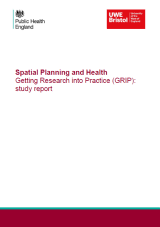Spatial Planning and Health Getting Research into Practice

The aim of this initiative undertaken by UWE for Public Health England (PHE), was to explore how local teams have been able to use PHE’s 2017 Resource, Spatial Planning and Health: evidence resource (opens new window), and the challenges of applying the principles set out in it at a local level.
In particular, Getting Research into Practice (GRIP) sought to identify those opportunities and barriers systematically, and through the learning generated, to consider how to support local public health and town planning professionals in better integrating health and wellbeing into local planning policies and decisions. The resultant report concludes by making recommendations for directors of public health, heads of planning, local authority public health and planning teams on how to best get health and wellbeing into planning locally so that:
- Local health and wellbeing needs and priorities are integrated into the local plan and decision-making process
- There are clear communication and engagement processes between public health and town planning teams
- There are local opportunities for joint training, education and continuing professional development across professions
- There are opportunities made to ensure that local politicians are aware of the wider impacts on health arising from planning as political support is essential to integrating health into planning at the local level • spatial planning and health tools and evidence are presented to meet the practical needs of both town planning and public health professionals, and
- Identify what access is needed to the ever-growing international and national evidence base on health and spatial planning, and how these can be systematically provided to support local practitioners
